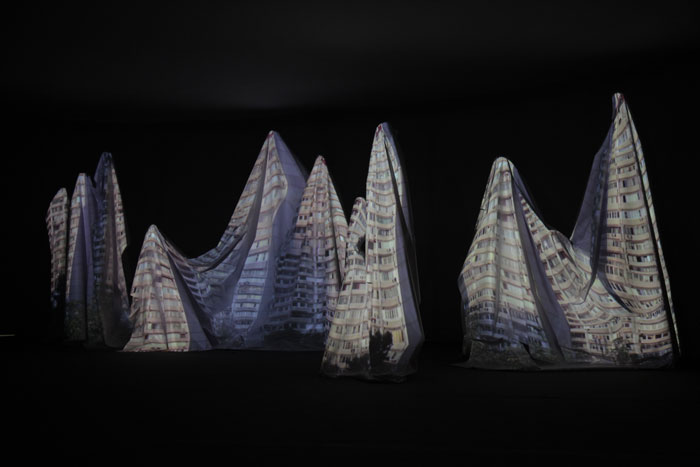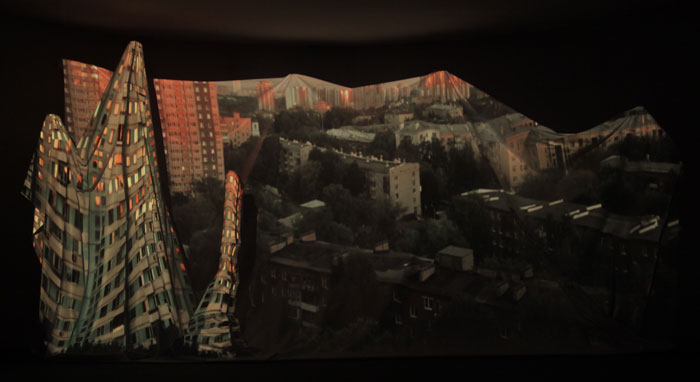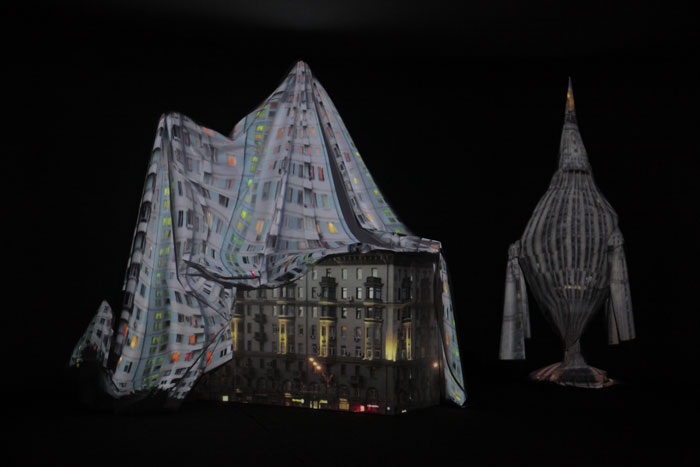TERMITARIES Manezh, Moscow 11.02 - 17.03.16
Termites are the first animals to have mastered the construction of “buildings” 200 million years ago. The biogenic structures of termitaries, made of sand and saliva parched by the sun, resemble the shapes of hills, mountains or chimneys. This world relies on agglomerated structures stronger than concrete.
Employing the medium of video associated with sculpture, the artist Dmitri Bulnygin refers to this type of housing, the termitary, to explore its organic forms as well as the universe of termites as a whole to further apply the principle of termite mounds to Moscow architecture.
The artist brings in video sculptures of termitaries amid the constructive and ornamental excesses of Moscow's eclectic architecture, using a selection of existing buildings constructed since the 1930s and up to the present day. The result is compact architecture, which resembles a pudding or a stalagmite at times.
A Stalinist skyscraper spreads into a neo-baroque curve, with an exaggerated horizontal expansion of the base, with angles eliminated and the material approached in terms of the mass, with forms being spongy and cavernous, as termitaries are entirely made of folds.
The material chosen for the cover is banner fabric. It is mostly used as a temporary cover during the restoration of facades in Moscow, but here, it serves as a projection surface for architectural dreams of greatness showing in marble skyscrapers or concrete towers.
The artist reinterprets the aesthetic language of housing, from the ornament of pompous academic styles to an improvised yurt between two chairs. The material of the cover serves as the medium to project the video of city lights on termite mounds. Here the picturesque landscape adjoins with temporary shelter.
The folds of cloth drape the structure, or what has to be hidden, for protection (either of the construction or ourselves) from unnecessary glances or frost. This cover belongs in the middle zone between what is hidden and what remains open, between the space of life and ruins. The folded shrinking termitaries convey the idea of the universal reduction. The change of scale creates an association with an empty or opening cocoon and fossil residues bearing an imprint of organic life.
This cover also invites associations with a shroud and the process of burial, where the veil becomes a limit isolating from the external world. The scenery of the video installation features the light spots, the termitaries, as a sign of the fragmented nature of the world. The projected architectural ideal here leaves nothing for the outside world; outside is void. A façade is an exterior without an interior, luminous with light and covered with blind and shut windows.
The “termitaries-folds” are also “termitaries-time”, as the projection renders only one angle of the building all day long. The video documenting the change of architecture captures the transformation of its form. The floors emerge and disappear depending on the lighting. Here, the video is linked to the architectural massive, and the hard folds of the termitary get animated under sun and wind.
And finally, there are “termitaries-songs”. Corresponding with the poetics of the day-night interval, the sound resonates with the repetitive pulse of light. This reminds that animals’ perceptions of the environment and their sensitivity are often linked to the brightness of light. A whole variety of sounds and songs of the bestiary opens up a different universe, the parallel universe of insects. The vibrations of life, the sounds of wind in the trees, the trajectory of the sun, electric light… follow the algorithm of video streaming that keeps the rhythm with the abundant fauna.
The termitary’s isolation implies the perception of its role as a fragment of the diverse world in its full variety and praises the ephemeral, the vibrations of animate beings and the persistence of all things.
Louise Morin


